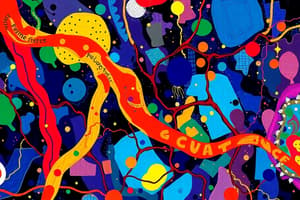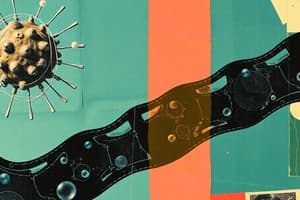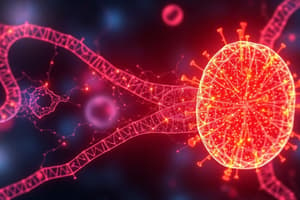Podcast
Questions and Answers
In paracrine signaling, the signaling molecule:
In paracrine signaling, the signaling molecule:
- is carried to the target cells via the circulation.
- acts on cells in close proximity to the secreting cell. (correct)
- acts on the same cells that secreted the signaling molecule.
- acts on target cells far away from the secreting cell.
GTPases serve in many signal transduction pathways and the presence of GTP or GDP dictates whether the pathway is on or off, respectively. Which of the following statements is TRUE regarding guanine nucleotide exchange factors (GEF) and the role in these signaling pathways?
GTPases serve in many signal transduction pathways and the presence of GTP or GDP dictates whether the pathway is on or off, respectively. Which of the following statements is TRUE regarding guanine nucleotide exchange factors (GEF) and the role in these signaling pathways?
- They hydrolyze GTP into GDP and Pi
- They decrease the GTPase activity of the G-protein.
- They catalyze the dissociation of GDP on the G-protein and promote the replacement of GTP. (correct)
- none of the above
Cell sensitivity to an external signal is determined by:
Cell sensitivity to an external signal is determined by:
- the number of surface receptors (correct)
- k on
- k off
- K d
If [R] = the free receptor concentration and [L] = the free ligand concentration, K, is:
If [R] = the free receptor concentration and [L] = the free ligand concentration, K, is:
Of the components of a heterotrimeric G protein, which subunit(s) is(are) able to activate downstream responses?
Of the components of a heterotrimeric G protein, which subunit(s) is(are) able to activate downstream responses?
In trimeric G proteins, GTP binds to:
In trimeric G proteins, GTP binds to:
Which of the following is NOT a common intracellular second messenger?
Which of the following is NOT a common intracellular second messenger?
Which of the following general statement(s) about a G protein-coupled receptor is (are) TRUE?
Which of the following general statement(s) about a G protein-coupled receptor is (are) TRUE?
All the following statement(s) about cholera toxin are TRUE, except:
All the following statement(s) about cholera toxin are TRUE, except:
Phosphatidylinositol 4,5-bisphosphate (PIP) is cleaved by phospholipase C into:
Phosphatidylinositol 4,5-bisphosphate (PIP) is cleaved by phospholipase C into:
1,2-diacylglycerol (DAG) and inositol 1,4,5-trisphosphate (IP3) are cleaved from phosphatidylinositol 4,5-bisphosphate (PIP2) by the enzyme:
1,2-diacylglycerol (DAG) and inositol 1,4,5-trisphosphate (IP3) are cleaved from phosphatidylinositol 4,5-bisphosphate (PIP2) by the enzyme:
cGMP phosphodiesterase catalyzes the conversion of:
cGMP phosphodiesterase catalyzes the conversion of:
Which enzyme plays a role in regulating rhodopsin-induced closing of cation channels?
Which enzyme plays a role in regulating rhodopsin-induced closing of cation channels?
Which of the following is a common step in the opening/closing of ion channels by acetylcholine and rhodopsin binding to their receptors?
Which of the following is a common step in the opening/closing of ion channels by acetylcholine and rhodopsin binding to their receptors?
Rhodopsin, a light-sensitive GPCR whose role in vision is dependent on its phosphorylation status, is influenced in part by the protein arrestin. Which of the following is TRUE with regard to rhodopsin and vision?
Rhodopsin, a light-sensitive GPCR whose role in vision is dependent on its phosphorylation status, is influenced in part by the protein arrestin. Which of the following is TRUE with regard to rhodopsin and vision?
The G protein stimulated by light via the Rhodopsin receptor is _ while the effector is _
The G protein stimulated by light via the Rhodopsin receptor is _ while the effector is _
Which of the following statements about adenylyl cyclase stimulation/inhibition in adipose cells is TRUE?
Which of the following statements about adenylyl cyclase stimulation/inhibition in adipose cells is TRUE?
Which of the following events occur during the epinephrine-stimulated conversion of glycogen to glucose-1-phosphate?
Which of the following events occur during the epinephrine-stimulated conversion of glycogen to glucose-1-phosphate?
The activity of β-adrenergic receptors is regulated by:
The activity of β-adrenergic receptors is regulated by:
Pull-down assays using proteins that ONLY bind to the GTP-bound version of the small G-protein can be used to detect when small G proteins like Rac1 have been activated by various growth factors. You were given two lysates, one having been treated with platelet-derived growth factor (PDGF) and the other not treated with PDGF. This method is similar to performing co-IPs, so based on that knowledge, which of the following steps is erroneous?
Pull-down assays using proteins that ONLY bind to the GTP-bound version of the small G-protein can be used to detect when small G proteins like Rac1 have been activated by various growth factors. You were given two lysates, one having been treated with platelet-derived growth factor (PDGF) and the other not treated with PDGF. This method is similar to performing co-IPs, so based on that knowledge, which of the following steps is erroneous?
Which of the following mechanisms can terminate an intracellular signaling pathway once the concentration of an external signal decreases?
Which of the following mechanisms can terminate an intracellular signaling pathway once the concentration of an external signal decreases?
Phospholipase C is activated by:
Phospholipase C is activated by:
When the regulatory domain of PKA is bound to cAMP:
When the regulatory domain of PKA is bound to cAMP:
Muscarinic acetylcholine receptors are GPCRs that slow the rate of heart muscle contraction upon ligand binding/activation. Activation of this receptor leads to opening of potassium channels triggered by decreases in cAMP levels. The muscarinic acetylcholine receptor likely couples to:
Muscarinic acetylcholine receptors are GPCRs that slow the rate of heart muscle contraction upon ligand binding/activation. Activation of this receptor leads to opening of potassium channels triggered by decreases in cAMP levels. The muscarinic acetylcholine receptor likely couples to:
Cholera toxin can make you sick through overactivation of a G𝛼s pathway even if your body stops making the ligand associated with activation of the pathway. Knowing this, which of the following CANNOT be true about cholera toxin?
Cholera toxin can make you sick through overactivation of a G𝛼s pathway even if your body stops making the ligand associated with activation of the pathway. Knowing this, which of the following CANNOT be true about cholera toxin?
Signal amplification is an important part of GPCR-mediated signaling. Which of the following steps do NOT directly amplify the signal?
Signal amplification is an important part of GPCR-mediated signaling. Which of the following steps do NOT directly amplify the signal?
One form of receptor desensitization can be mediated by negative feedback involving phosphorylation of the receptor itself by a kinase activated downstream of a second messenger. The phosphorylated receptor likely:
One form of receptor desensitization can be mediated by negative feedback involving phosphorylation of the receptor itself by a kinase activated downstream of a second messenger. The phosphorylated receptor likely:
Which type of experimental evidence shows that the intrinsic GTPase activity of the Ga subunit is important for terminating effector activation?
Which type of experimental evidence shows that the intrinsic GTPase activity of the Ga subunit is important for terminating effector activation?
A mutation renders a Gαq subunit constitutively active (also known as dominant active). Which of the following effects might you observe in a cell with this mutation?
A mutation renders a Gαq subunit constitutively active (also known as dominant active). Which of the following effects might you observe in a cell with this mutation?
Diacylglycerol (DAG) formation aids in cell signaling by:
Diacylglycerol (DAG) formation aids in cell signaling by:
β-blockers inhibit an adrenergic receptor found on many cell types in the body, including heart cells. Patients who have arrhythmias (irregular heartbeats) most likely benefit from what downstream action of these drugs?
β-blockers inhibit an adrenergic receptor found on many cell types in the body, including heart cells. Patients who have arrhythmias (irregular heartbeats) most likely benefit from what downstream action of these drugs?
Calmodulin:
Calmodulin:
DAG activates:
DAG activates:
In muscle, glycogen phosphorylase kinase can be activated by nerve stimulation even in the absence of hormonal signals. Nerve stimulation alone results in activation of glycogen phosphorylase kinase as a result of:
In muscle, glycogen phosphorylase kinase can be activated by nerve stimulation even in the absence of hormonal signals. Nerve stimulation alone results in activation of glycogen phosphorylase kinase as a result of:
After a meal, when blood glucose rises, circulating insulin binds to insulin receptors on various cell types and reduces blood glucose levels by:
After a meal, when blood glucose rises, circulating insulin binds to insulin receptors on various cell types and reduces blood glucose levels by:
Flashcards
Paracrine Signaling
Paracrine Signaling
Signaling molecules act on nearby cells.
Guanine nucleotide exchange factor (GEF)
Guanine nucleotide exchange factor (GEF)
Catalyzes GDP release and GTP binding on G protein, activating it.
Endocrine Signaling
Endocrine Signaling
Signaling molecules released into the bloodstream to act on distant cells.
Autocrine Signaling
Autocrine Signaling
Signup and view all the flashcards
Kd
Kd
Signup and view all the flashcards
Agonist
Agonist
Signup and view all the flashcards
Antagonist
Antagonist
Signup and view all the flashcards
Heterotrimeric G protein
Heterotrimeric G protein
Signup and view all the flashcards
G protein-coupled receptor (GPCR)
G protein-coupled receptor (GPCR)
Signup and view all the flashcards
Second Messenger
Second Messenger
Signup and view all the flashcards
cAMP
cAMP
Signup and view all the flashcards
Phospholipase C (PLC)
Phospholipase C (PLC)
Signup and view all the flashcards
Cholera Toxin
Cholera Toxin
Signup and view all the flashcards
Protein Kinase A (PKA)
Protein Kinase A (PKA)
Signup and view all the flashcards
Study Notes
Signal Transduction and G-Protein Coupled Receptors
- Signal transduction pathways involve a series of molecular events that transmit a signal from the cell's exterior to the interior, producing downstream effects.
- Paracrine signaling involves signaling molecules acting on nearby cells, while endocrine signaling uses the circulatory system to reach distant cells.
- Autocrine signaling occurs when a cell releases a signaling molecule that affects the same cell that released it.
- G-protein coupled receptors (GPCRs) are a large family of transmembrane proteins involved in signal transduction.
- The presence of GTP or GDP on GTPase proteins dictates the pathway’s “on” or “off” state, respectively.
- Guanine nucleotide exchange factors (GEFs) promote the exchange of GDP for GTP.
- An antagonist binds to the receptor but doesn't trigger a response, while an agonist mimics a natural ligand, initiating the normal response.
- Cell sensitivity depends on various factors, including the number of surface receptors.
- The dissociation constant (Kd) measures how tightly a ligand binds to a receptor.
- Competitive binding assays can measure drug binding to receptors.
- Functional domains of GPCRs can be identified through recombinant chimeric receptor studies.
- Pull-down assays can detect active Rac1 (a small G protein), identifying signaling pathway activation by growth factors.
- Heterotrimeric G proteins, with alpha, beta, and gamma subunits, are crucial for signal transduction.
- The alpha subunit, when bound to GTP, dissociates from beta/gamma subunits to activate downstream responses.
- Second messengers, like inositol trisphosphate (IP3) and diacylglycerol (DAG), are intracellular signaling molecules involved in diverse cellular responses.
- Phospholipase C cleaves phosphatidylinositol 4,5-bisphosphate(PIP2) into DAG and IP3.
Studying That Suits You
Use AI to generate personalized quizzes and flashcards to suit your learning preferences.




